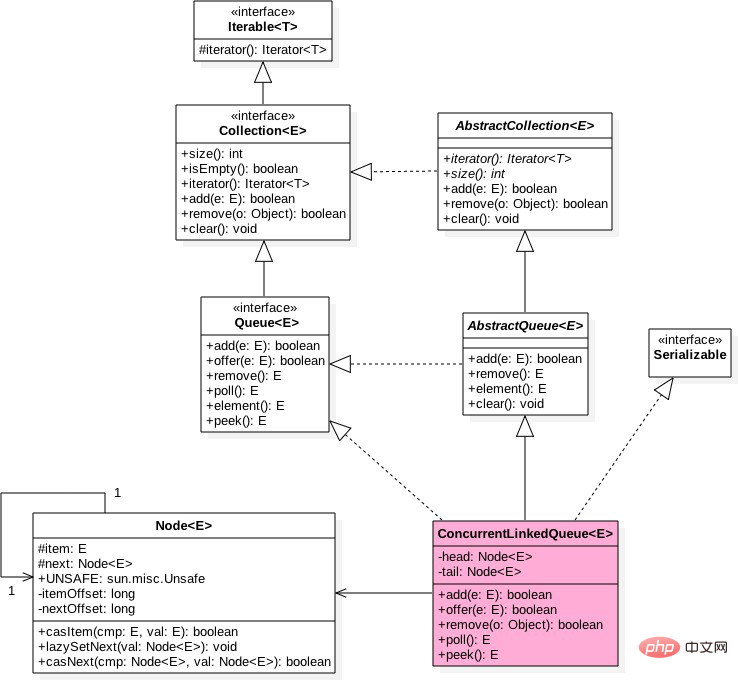java多线程和并发面试题目(第4题,附答案)

4、ConcurrentLinkedQueue非阻塞无界链表队列
ConcurrentLinkedQueue是一个线程安全的队列,基于链表结构实现,是一个无界队列,理论上来说队列的长度可以无限扩大。
与其他队列相同,ConcurrentLinkedQueue也采用的是先进先出(FIFO)入队规则,对元素进行排序。 (推荐学习:java面试题目)
当我们向队列中添加元素时,新插入的元素会插入到队列的尾部;而当我们获取一个元素时,它会从队列的头部中取出。
因为ConcurrentLinkedQueue是链表结构,所以当入队时,插入的元素依次向后延伸,形成链表;而出队时,则从链表的第一个元素开始获取,依次递增;
值得注意的是,在使用ConcurrentLinkedQueue时,如果涉及到队列是否为空的判断,切记不可使用size()==0的做法,因为在size()方法中,是通过遍历整个链表来实现的,在队列元素很多的时候,size()方法十分消耗性能和时间,只是单纯的判断队列为空使用isEmpty()即可。
public class ConcurrentLinkedQueueTest {<br/> public static int threadCount = 10;<br/> public static ConcurrentLinkedQueue<String> queue = new ConcurrentLinkedQueue<String>();<br/> static class Offer implements Runnable {<br/> public void run() {<br/> //不建议使用 queue.size()==0,影响效率。可以使用!queue.isEmpty()<br/> if (queue.size() == 0) {<br/> String ele = new Random().nextInt(Integer.MAX_VALUE) + "";<br/> queue.offer(ele);<br/> System.out.println("入队元素为" + ele);<br/> }<br/> }<br/> }<br/> static class Poll implements Runnable {<br/> public void run() {<br/> if (!queue.isEmpty()) {<br/> String ele = queue.poll();<br/> System.out.println("出队元素为" + ele);<br/> }<br/> }<br/> }<br/> public static void main(String[] agrs) {<br/> ExecutorService executorService = Executors.newFixedThreadPool(4);<br/> for (int x = 0; x < threadCount; x++) {<br/> executorService.submit(new Offer());<br/> executorService.submit(new Poll());<br/> }<br/> executorService.shutdown();<br/> }<br/>}<br/>一种输出:
入队元素为313732926<br/>出队元素为313732926<br/>入队元素为812655435<br/>出队元素为812655435<br/>入队元素为1893079357<br/>出队元素为1893079357<br/>入队元素为1137820958<br/>出队元素为1137820958<br/>入队元素为1965962048<br/>出队元素为1965962048<br/>出队元素为685567162<br/>入队元素为685567162<br/>出队元素为1441081163<br/>入队元素为1441081163<br/>出队元素为1627184732<br/>入队元素为1627184732<br/>
ConcurrentLinkedQuere类图

如图ConcurrentLinkedQueue中有两个volatile类型的Node节点分别用来存在列表的首尾节点,其中head节点存放链表第一个item为null的节点,tail则并不是总指向最后一个节点。
Node节点内部则维护一个变量item用来存放节点的值,next用来存放下一个节点,从而链接为一个单向无界列表。
public ConcurrentLinkedQueue(){<br/> head=tail=new Node<E>(null);<br/>}<br/>如上代码初始化时候会构建一个 item 为 NULL 的空节点作为链表的首尾节点。
Offer 操作offer 操作是在链表末尾添加一个元素,
下面看看实现原理。
public boolean offer(E e) {<br/> //e 为 null 则抛出空指针异常<br/> checkNotNull(e);<br/> //构造 Node 节点构造函数内部调用 unsafe.putObject,后面统一讲<br/> final Node<E> newNode = new Node<E>(e);<br/> //从尾节点插入<br/> for (Node<E> t = tail, p = t; ; ) {<br/> Node<E> q = p.next;<br/> //如果 q=null 说明 p 是尾节点则插入<br/> if (q == null) {<br/> //cas 插入(1)<br/> if (p.casNext(null, newNode)) {<br/> //cas 成功说明新增节点已经被放入链表,然后设置当前尾节点(包含 head,1,3,5.。。个节点为尾节点)<br/> if (p != t)// hop two nodes at a time<br/> casTail(t, newNode); // Failure is OK. return true;<br/> }<br/> // Lost CAS race to another thread; re-read next<br/> } else if (p == q)//(2)<br/> //多线程操作时候,由于 poll 时候会把老的 head 变为自引用,然后 head 的 next 变为新 head,所以这里需要<br/> //重新找新的 head,因为新的 head 后面的节点才是激活的节点<br/> p = (t != (t = tail)) ? t : head;<br/> else<br/> // 寻找尾节点(3)<br/> p = (p != t && t != (t = tail)) ? t : q;<br/> }<br/>}<br/>从构造函数知道一开始有个item为null的哨兵节点,并且head和tail都是指向这个节点。
Atas ialah kandungan terperinci java多线程和并发面试题目(第4题,附答案). Untuk maklumat lanjut, sila ikut artikel berkaitan lain di laman web China PHP!

Alat AI Hot

Undresser.AI Undress
Apl berkuasa AI untuk mencipta foto bogel yang realistik

AI Clothes Remover
Alat AI dalam talian untuk mengeluarkan pakaian daripada foto.

Undress AI Tool
Gambar buka pakaian secara percuma

Clothoff.io
Penyingkiran pakaian AI

AI Hentai Generator
Menjana ai hentai secara percuma.

Artikel Panas

Alat panas

Notepad++7.3.1
Editor kod yang mudah digunakan dan percuma

SublimeText3 versi Cina
Versi Cina, sangat mudah digunakan

Hantar Studio 13.0.1
Persekitaran pembangunan bersepadu PHP yang berkuasa

Dreamweaver CS6
Alat pembangunan web visual

SublimeText3 versi Mac
Perisian penyuntingan kod peringkat Tuhan (SublimeText3)

Topik panas
 1385
1385
 52
52
 Nombor Sempurna di Jawa
Aug 30, 2024 pm 04:28 PM
Nombor Sempurna di Jawa
Aug 30, 2024 pm 04:28 PM
Panduan Nombor Sempurna di Jawa. Di sini kita membincangkan Definisi, Bagaimana untuk menyemak nombor Perfect dalam Java?, contoh dengan pelaksanaan kod.
 Weka di Jawa
Aug 30, 2024 pm 04:28 PM
Weka di Jawa
Aug 30, 2024 pm 04:28 PM
Panduan untuk Weka di Jawa. Di sini kita membincangkan Pengenalan, cara menggunakan weka java, jenis platform, dan kelebihan dengan contoh.
 Nombor Smith di Jawa
Aug 30, 2024 pm 04:28 PM
Nombor Smith di Jawa
Aug 30, 2024 pm 04:28 PM
Panduan untuk Nombor Smith di Jawa. Di sini kita membincangkan Definisi, Bagaimana untuk menyemak nombor smith di Jawa? contoh dengan pelaksanaan kod.
 Soalan Temuduga Java Spring
Aug 30, 2024 pm 04:29 PM
Soalan Temuduga Java Spring
Aug 30, 2024 pm 04:29 PM
Dalam artikel ini, kami telah menyimpan Soalan Temuduga Spring Java yang paling banyak ditanya dengan jawapan terperinci mereka. Supaya anda boleh memecahkan temuduga.
 Cuti atau kembali dari Java 8 Stream Foreach?
Feb 07, 2025 pm 12:09 PM
Cuti atau kembali dari Java 8 Stream Foreach?
Feb 07, 2025 pm 12:09 PM
Java 8 memperkenalkan API Stream, menyediakan cara yang kuat dan ekspresif untuk memproses koleksi data. Walau bagaimanapun, soalan biasa apabila menggunakan aliran adalah: bagaimana untuk memecahkan atau kembali dari operasi foreach? Gelung tradisional membolehkan gangguan awal atau pulangan, tetapi kaedah Foreach Stream tidak menyokong secara langsung kaedah ini. Artikel ini akan menerangkan sebab -sebab dan meneroka kaedah alternatif untuk melaksanakan penamatan pramatang dalam sistem pemprosesan aliran. Bacaan Lanjut: Penambahbaikan API Java Stream Memahami aliran aliran Kaedah Foreach adalah operasi terminal yang melakukan satu operasi pada setiap elemen dalam aliran. Niat reka bentuknya adalah
 TimeStamp to Date in Java
Aug 30, 2024 pm 04:28 PM
TimeStamp to Date in Java
Aug 30, 2024 pm 04:28 PM
Panduan untuk TimeStamp to Date di Java. Di sini kita juga membincangkan pengenalan dan cara menukar cap waktu kepada tarikh dalam java bersama-sama dengan contoh.
 Program Java untuk mencari kelantangan kapsul
Feb 07, 2025 am 11:37 AM
Program Java untuk mencari kelantangan kapsul
Feb 07, 2025 am 11:37 AM
Kapsul adalah angka geometri tiga dimensi, terdiri daripada silinder dan hemisfera di kedua-dua hujungnya. Jumlah kapsul boleh dikira dengan menambahkan isipadu silinder dan jumlah hemisfera di kedua -dua hujungnya. Tutorial ini akan membincangkan cara mengira jumlah kapsul yang diberikan dalam Java menggunakan kaedah yang berbeza. Formula volum kapsul Formula untuk jumlah kapsul adalah seperti berikut: Kelantangan kapsul = isipadu isipadu silinder Dua jumlah hemisfera dalam, R: Radius hemisfera. H: Ketinggian silinder (tidak termasuk hemisfera). Contoh 1 masukkan Jejari = 5 unit Ketinggian = 10 unit Output Jilid = 1570.8 Unit padu menjelaskan Kirakan kelantangan menggunakan formula: Kelantangan = π × r2 × h (4
 Bagaimana untuk menjalankan aplikasi boot musim bunga pertama anda di Spring Tool Suite?
Feb 07, 2025 pm 12:11 PM
Bagaimana untuk menjalankan aplikasi boot musim bunga pertama anda di Spring Tool Suite?
Feb 07, 2025 pm 12:11 PM
Spring Boot memudahkan penciptaan aplikasi Java yang mantap, berskala, dan siap pengeluaran, merevolusi pembangunan Java. Pendekatan "Konvensyen Lebih Konfigurasi", yang wujud pada ekosistem musim bunga, meminimumkan persediaan manual, Allo




